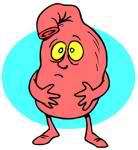
Aspergers (high functioning autism) is a developmental disorder, which was first described around 1940, about three years after the introduction of the first main commercial antibiotics (i.e., sulfa drugs). As antibiotic usage grows, so do rates of Autism Spectrum Disorders. Aspergers is really a disorder of the antibiotic era. Why? Simply because antibiotics help the yeast Candida albicans grow within the intestinal tract. Candida albicans makes toxic chemicals, which hurt the developing brain.
The yeast Candida albicans can be discovered inside of our intestinal tract, mouth and in the female genital tract. Occasionally this yeast overgrows and the doctor recognizes this overgrowth of yeast as a yeast infection of the female genital tract or in the mouth, where this infection is commonly known as thrush.
Bacteria are also resident inside the intestinal tract, sharing space with the yeast. Antibiotics kill bacteria, not yeast. After the use of antibiotics, the yeast grows to fill in the space left by the removal of the bacteria. Yeast makes chemicals which kill bacteria, which enables the yeast to grow at a greater level, even after the antibiotics have been stopped.
Yeast makes numerous chemical compounds which are then picked up and absorbed into the body. These compounds are quite toxic to the nervous system. These compounds include toxic alcohols and acetone, as well as the powerful nervous system poison hydrogen sulfide. Alcohols depress and slow the nervous system and acetone causes coma. These chemicals slow the brain down to ensure that the brain no longer works properly. These chemicals ought to be cleared by the liver so that these chemicals by no means reach the brain. Nevertheless in some individuals, these chemicals are apparently not cleared, reach the brain, and cause mental symptoms.
Slowing of the brain, especially in speech areas has been found in brains of Aspergers kids. Alcohols are well known to disrupt brain development. There are also chemicals in the diet which slow the brain down. Barley malt, the raw material for generating beer, contains twenty chemicals which slow the brain down. Vinegar also contains such chemicals.
The mixture of chemicals from internal yeast and from food could partially account for the finding of the brain slowing in Aspergers kids. The essential reason to take a look at yeast as a main contributor to Aspergers causation is that yeast is effortlessly and safely treatable.
The method to reverse this yeast problem would be to take the anti-yeast drug nystatin. This drug is not absorbed and kills the yeast living in the intestinal tract. Then the yeast can no longer make the toxic chemical compounds. Second, the diet contains numerous foods which include yeast compounds. Some of these yeast chemicals are toxic to bacteria and will clear space for the yeast to grow once more. If these yeast chemicals are left within the diet plan, nystatin will not do a lot simply because the yeast keeps growing back. To treat yeast, these foods should be removed from the diet. Removal of these dietary yeast goods enables nystatin to kill the yeast without the yeast growing back. Malt contains chains of sugar molecules, which most likely inhibit the body's immune method. This inhibition makes it tough for the immune system to fight Candida. Malt must be removed to clear Candida.
Fortunately, simply because nystatin isn't absorbed, nystatin causes no side effects except for a bit of nausea. Consequently there is no risk to this therapy. The diet plan for Candida issues consists of removing fermented foods from the diet plan. The worst offenders are alcoholic beverages and non-alcoholic beer, vinegar, barley malt, chocolate, pickles, soy sauce and aged cheese.
Nearly every youngster who has followed this anti-yeast therapy has improved. Kids who can speak usually speak better and more often. Kids under 2½ who can talk a little can be brought back to regular or near normal. Behavior and sleep all enhance. Kids are calmer and easier to teach.
Gluten Free / Casein Free Diet—
Where does the gluten free casein free diet fit in? This diet comes from research on schizophrenia, in which these gluten and casein protein fragments were found within the urine of schizophrenic patients. Similar urine profiles had been later found within the urine of Aspergers kids.
The role of opioids in Aspergers is as follows. Milk and dairy include a protein known as casein and wheat contains a protein called gluten. Inside of both casein and gluten are structures that are tough for the body to digest totally. The structures or peptides remaining following digestion of casein and gluten react at particular sites in the brain called opioid receptors. These sites are so named simply because these sites are where opiate drugs such as morphine act. The internal chemicals which react at the opioid receptors within the brain are called endorphins. These peptide structures from the diet plan have several names, one of which is "opioids".
In experimental studies, opiate drugs like morphine have been found to bind to brain opioid receptors and this binding leads to decreased glucose (sugar) utilization and decreased metabolic rate. In other words structures which bind to opioid receptors in the brain slow the brain down. As already noted, the one discovery that stands up in the brains of Aspergers kids is that the brain is slowed down (metabolically less active) as shown by decreased blood flow, especially in speech areas.
Presumably these casein and gluten protein fragments also slow the brain down. This has led to the treatment of excluding casein and gluten from the diet of Aspergers kids. You will find many commercial goods available to support such treatment.
How good is the gluten free casein free diet plan? The main studies show that kids do much better in school. Some kids improve, some only modestly and some barely at all. Why? The gluten free casein totally free diet plan is not an anti yeast diet plan. The gluten free casein totally free diet plan permits some main yeast offenders such as vinegar, pickles, chocolate, peanut butter and corn. Both peanuts and corn are frequently contaminated with mold. Chicken are fed much cottonseed and cottonseed is contaminated with mold.
So if a youngster is taken off gluten and casein, but is continued on vinegar and is put on more chicken, peanut butter and corn, what will occur? Whatever benefits there are from removing gluten and casein will be taken away by adding to the diet more mold within the type of chicken, peanut butter and corn. The intestinal yeast will still be there making toxic chemicals. The youngster will show only minimal improvement and the improvement and behavior will fluctuate, based on what the youngster has eaten.
This gluten free/casein free diet is frequently recommended today as the main factor to help Aspergers kids. However, be sure implement the gluten free/casein free diet AFTER the anti-yeast diet has begun. The gluten free/casein diet plan allows eating of vinegar, pickles, along with other foods containing toxic yeast chemicals that are quite toxic to the brains of Aspergers kids. Except for elimination of malt, there is no overlap between foods eliminated on a gluten free/casein free diet plan and foods eliminated on Stage 1 of the anti-yeast diet. Malt (which is actually a specially sprouted barley product) should be eliminated on a gluten free/casein free diet plan and malt will be the number 1 item to eliminate on an anti-yeast diet. Nevertheless, too many other foods containing toxic chemicals could be left in on a gluten free/casein free diet plan, to make use of this diet plan as the only therapy.
High Dose Vitamins and Minerals—
What about high doses of vitamins and minerals? Vitamin B-6 neutralizes among the yeast chemicals and this yeast chemical takes the location of magnesium at important locations in the body. The neutralization of this chemical might explain why vitamin B-6 and magnesium are occasionally helpful. However, it's much better to clear out the yeast, so that the chemical is no longer created rather than to try to neutralize it. There are many other yeast chemicals which are not affected by vitamin B-6 and magnesium.
Moms and dads who continue the high doses of vitamins and minerals and then attempt to add nystatin often discover that nystatin isn't useful. Among the vitamins, perhaps vitamin B-6, binds to nystatin, making it ineffective. Moms and dads should not make use of the high doses of vitamins and minerals while giving nystatin.
Acidophilus—
Acidophilus is not recommended because it helps yeast grow. Acidophilus may seem to assist because it clears out another poor microorganism, Clostridia, but acidophilus does nothing for yeast. Acidophilus makes an anti-bacterial chemical. Acidophilus ought to only be utilized short-term, not long-term.
Particular Carbohydrate Diet—
Some people for their Aspergers kids attempt the specific carbohydrate diet plan. This diet plan is used for individuals with major allergic reactions. This diet is not an anti-yeast diet. This diet consists of simple food molecules which the yeast Candida can effortlessly use to grow. For fighting yeast, the specific carbohydrate diet has no location and might make the yeast and the Aspergers worse.
Yeast and the Immune System—
Why can the body's immune system not clear Candida? The Candida has many tricks to evade the body's immune method. The immune method then calls within the reinforcements. These immune cells attack the yeast and create the signals for inflammation. Inflammation is really a defense, like a wall to keep out the Candida. The Candida is still there, which indicates the inflammation remains.
Within the intestine, this continued inflammation leads to Crohn's disease and ulcerative colitis. Occasionally these immune cells circulate and discover yeast cells in other locations. There is yeast on the skin. Again the yeast is evasive and also the immune cells generate the signals for inflammation. The yeast is not cleared and also the inflammation remains. This leads to skin issues from itching and eczema to psoriasis.
The Candida has also evolved to look like our own cells. Candida has the body's own connective tissue receptor on it, which it uses to anchor itself into our tissues. Sometimes the immune cells, as they attack the yeast, attack anything which looks like the yeast.
What else looks like the yeast? Body cells which have the connective tissue receptor. This attacking of body cells leads to "autoimmune diseases" such as numerous sclerosis and rheumatoid arthritis. In these diseases, the body's immune method appears to be attacking the body's own tissues. The immune cells are attacking the yeast and then attacking anything which looks like the yeast.
The yeast chemicals slow the brain down. The gut has its own brain to make certain all of the food goes through the intestinal tract at the right rate. What will happen if yeast chemicals put the gut's brain to sleep? The result will be constipation, sometimes very severe. Diarrhea is the body's attempt to clear the yeast. The diarrhea could be present at the exact same time as the constipation, which is why they are able to alternate.
What occurs if the yeast chemicals slow down the body's nerves and put them to sleep? Then the youngster can't really feel anything or absolutely nothing feels correct. The hardest parts of the nerves to numb up are the parts which carry discomfort. This is why light touch, rather of feeling pleasant, now feels painful. If the nerves are numb, occasionally pain feels better than absolutely nothing at all. This is why these kids bang their heads. Even the discomfort feels better than numbness.
The lack of correct sensation in the mouth is a reason why these kids can become picky eaters. Foods, especially new ones don't feel correct to them. The picky consuming improves with anti-yeast treatment.
Sleep Problems—
Why do Aspergers kids have such trouble sleeping? There are numerous chemicals which put their brains to sleep. But the brain doesn't wish to go to sleep from these chemicals. How does the brain fight these chemicals? The brain stays awake. When the chemicals are removed, kids sleep much better. These chemicals also cause headaches and abdominal pain.
Melatonin is really a natural hormone made within the brain when it's dark. Melatonin is really a signal for individuals to go to sleep. For unknown reasons, Aspergers kids don't appear to make enough melatonin or maybe they make enough, but do not respond to it, so they stay awake for lengthy periods of time when others could be asleep.
Giving melatonin at night is helpful in promoting sleep. Make sure to obtain a brand that contains only melatonin, and isn't mixed with vitamins or other substances. Some brands may also contain other allergens, like wheat or dairy or casein. Search for melatonin mixed in powdered rice. Begin with 1/2 capsule (about 1.five mg.) mixed in a little quantity of food, given at bedtime, preferably when it's already dark. Melatonin isn't a sleeping pill and does not act like one. You'll not see the child drop off suddenly to sleep. Rather, it promotes natural sleep.
Antibiotics and Aspergers—
It's better to steer clear of giving antibiotics to kids who have yeast problems because the antibiotics help yeast grow. However, in case of serious illness, you need to be guided by your physician. How does one avoid giving antibiotics to kids? Kids who're treated for yeast usually have fewer infections, and those that they've are much less severe. Why?
Back within the days before high tech, researchers asked a lot simpler questions. They asked whether Candida and tuberculosis like one another. Do they grow better together? The answer is yes. Candida's capsule assists tuberculosis to grow. This kind of experiment has been carried out with other infectious microorganisms and yeast assists other poor microorganisms to grow. Candida helps the microorganisms at the back of the mouth to grow and to grow back after antibiotics. The Candida helping the bad microorganisms is why kids get ear infection after ear infection.
IEP Containing Dietary Restrictions—
An Individualized Education Plan (IEP) is usually developed for kids who qualify for special education under federal law. If your youngster has an IEP and is following a specialized diet, the IEP should contain information that makes the entire school aware of the dietary restrictions. In the IEP, designate in the appropriate place that your youngster is on a special diet for his condition that necessitates the IEP.
Here is an example of “dietary restrictions” noted within an IEP:
[Child] is on a special diet to treat his/her__________.
[Child] may only eat foods that are sent from home.
If other foods are available in school as treats or snacks, [Child] may eat the following: [list all of the foods your youngster can eat].
Staff may not supplement [Child's] diet in any way, as treats, incentives or for any other reasons, without first obtaining parental consent, unless the food is listed above.
Staff shall inform parent as much as possible about upcoming parties, treats, school projects, etc., involving food, so parent can send in appropriate treats for [Child].
[Child] may not share or trade food. Staff must supervise [Child] during snack and meals to ensure that he/she eats safely. Any deviation from [Child's] diet will likely result in severe behavioral symptoms, which may include: kicking, hitting, biting, head banging, pinching, scratching, grabbing, stomach pain, head pain, lack of cooperation, hyperactivity, lack of concentration [list any other that you have experienced].
Staff shall be trained and made aware of the dietary restrictions and the [Child's] diet. If [Child] eats something that he/she is not supposed to eat, which results in one or more of the behavioral problems listed above, the school will not suspend or expel him/her, because such behavioral problems are a direct manifestation of [Child's] condition of _______________.
 Everyone with Aspergers is unique, so interventions need to be individualized. Grown-ups come to this awareness at different ages and stages of their lives, which can influence the approaches they choose. Be creative in the combination of interventions you use. Simplify your life. Here are some general ideas regarding interventions for grown-ups with Aspergers:
Everyone with Aspergers is unique, so interventions need to be individualized. Grown-ups come to this awareness at different ages and stages of their lives, which can influence the approaches they choose. Be creative in the combination of interventions you use. Simplify your life. Here are some general ideas regarding interventions for grown-ups with Aspergers:


.jpg)


